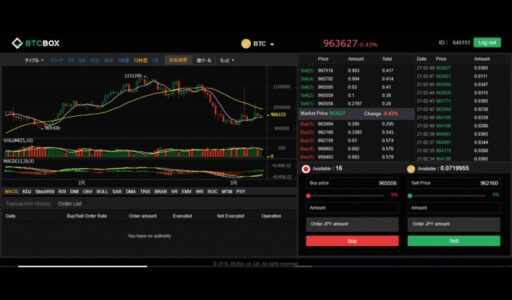The world of cryptocurrency isn’t new, but it’s a constantly evolving landscape that can be both exciting and perplexing, especially when it comes to navigating crypto exchanges. These platforms are the backbone of digital currency trading, and since Bitcoin’s inception in 2009, their role has become increasingly significant. This article aims to demystify the complex world of crypto like-kind exchanges, providing insights into their mechanics, the importance of user experience, and strategies for optimizing your crypto portfolio.
Key Takeaways
- Understanding the types and features of crypto exchanges is crucial for effective trading and portfolio management.
- Security, order matching, and the impact of regulations are fundamental aspects of how crypto exchanges operate.
- Optimizing a crypto portfolio involves strategies for diversification, utilizing crypto swaps, and assessing trading costs.
- User experience is enhanced by exchanges focusing on accessibility, education, and robust customer support.
- Selecting the right exchange requires due diligence, with an emphasis on security, reliability, and adaptation to market trends.
Understanding the Landscape of Crypto Exchanges
The Evolution of Cryptocurrency Trading Platforms
The cryptocurrency exchange landscape has undergone significant transformation since the inception of digital currencies. Early platforms faced numerous challenges, including security issues, limited user interfaces, and regulatory uncertainty. However, the industry has seen remarkable innovations such as the introduction of decentralized exchanges (DEXs), hybrid platforms, and the integration of emerging technologies.
The future of cryptocurrency exchanges looks promising, with trends indicating a shift towards more sophisticated and user-centric platforms. These advancements are not only enhancing the trading experience but also expanding the possibilities within the digital asset space. For instance, the integration of decentralized finance (DeFi) components allows exchanges to offer a broader range of financial instruments.
As the regulatory landscape evolves, exchanges are adapting to meet new compliance standards, ensuring a safer and more reliable environment for traders. The table below highlights some of the key trends and their potential impact on the future of cryptocurrency trading:
| Trend | Potential Impact |
|---|---|
| DeFi Integration | Offers sophisticated financial instruments |
| Regulatory Evolution | Ensures compliance and trader safety |
| Technological Advancements | Enhances trading experience and capabilities |
The continuous evolution of crypto exchanges is pivotal in shaping the future of digital currency trading, providing users with innovative tools to optimize their strategies and manage their portfolios effectively.
Centralized vs. Decentralized Exchanges: Pros and Cons
When delving into the realm of cryptocurrency trading, one must choose between centralized exchanges (CEXs) and decentralized exchanges (DEXs). Centralized exchanges are akin to traditional financial institutions, holding your crypto on their servers and providing a more user-friendly interface. They often support a variety of payment options and boast high liquidity, making them a popular choice for many traders.
However, centralized exchanges are not without their drawbacks. They are susceptible to security risks due to their centralized nature, which can be a significant concern for users. On the other hand, decentralized exchanges operate on a peer-to-peer basis, offering greater anonymity and control over your assets. These platforms rely on smart contracts, which can provide better privacy and potentially lower transaction costs.
While both types of exchanges have their merits, it’s essential to weigh their pros and cons in relation to your trading needs and risk tolerance.
Selecting the right exchange involves considering factors such as ease of use, security, and the level of control you wish to maintain over your transactions. It’s crucial to understand that crypto exchanges must comply with complex regulations like KYC and AML, which can affect the user experience and the level of privacy offered.
Key Features to Look for in a Crypto Exchange
When venturing into the world of cryptocurrency trading, selecting the right exchange is a critical step. Security should be your top priority, as exchanges are frequent targets for cyber attacks. Look for platforms that implement two-factor authentication, strong encryption protocols, and have a solid track record of dealing with security breaches.
Fees and user experience are also vital considerations. A cost-effective exchange with low trading fees can significantly impact your investment returns. Moreover, an exchange with a user-friendly interface and responsive customer support will enhance your trading activities. It’s essential to compare these features across various platforms to find the one that best suits your needs.
Remember, the reliability and reputation of a crypto exchange are fundamental to your trading success. Conduct thorough research on the exchange’s founders, legitimacy, and customer service record before making your choice.
The Mechanics of Crypto Trading: How Exchanges Operate
The Role of Order Books in Matching Trades
At the heart of every cryptocurrency exchange lies the order book, a dynamic ledger that records all buy and sell orders placed by users. It’s a critical tool for traders to understand market sentiment and to execute trades effectively. The order book lists current orders with their respective prices and volumes, providing a snapshot of market activity at any given moment.
The matching of orders is a fundamental function of crypto exchanges, ensuring that trades are executed fairly and efficiently.
There are two primary methods for matching orders on an exchange: market orders and limit orders. Market orders are executed at the best available price, offering speed but sometimes at the cost of price certainty. Limit orders, on the other hand, allow users to set a specific price for their trade, offering control over the transaction price but potentially leading to slower execution.
Centralized exchanges (CEXs) utilize an order book system to organize orders by price. The matching engine then pairs buyers and sellers based on the most suitable executable price for the desired lot size. The price of a digital asset, whether it’s fiat currency or cryptocurrency, is ultimately determined by the supply and demand for that asset.
Security Measures and Their Importance
In the realm of cryptocurrency trading, security is not just a feature, but a necessity. The digital nature of assets makes them particularly susceptible to online threats, hence the implementation of rigorous security measures is crucial for protecting investors’ funds and personal information.
- Strong Passwords & 2FA: Your password is the first line of defense. Using a unique, complex password combined with two-factor authentication (2FA) can significantly enhance account security.
- Multi-signature Wallets: These wallets require multiple approvals for transactions, adding an additional layer of security against unauthorized access.
- Regular Security Audits: Choose exchanges that conduct independent security audits to proactively identify and rectify vulnerabilities.
It is essential to remain vigilant and proactive in maintaining security. Regularly updating anti-virus and anti-malware software, avoiding public Wi-Fi for trading activities, and keeping software up to date with security patches are all user responsibilities that complement the exchange’s security protocols.
Choosing a trustworthy crypto exchange involves evaluating security, regulatory compliance, and user reviews. It’s important to consider the trade-offs between KYC and non-KYC exchanges, and to utilize cost-effective trading strategies for enhanced performance and returns.
The Impact of Regulations on Exchange Operations
The evolving regulatory landscape is a critical factor shaping the operations of cryptocurrency exchanges. Regulations aim to address issues such as price manipulation and the need for consumer protection, enhancing the overall trust in the crypto market. As regulatory bodies work to establish clear frameworks, exchanges must adapt to comply with new rules and standards.
- Compliance with KYC/AML regulations is essential for preventing illegal activities and ensuring a secure trading environment.
- Exchanges may face token classification and licensing requirements, affecting how they handle different cryptocurrencies.
- The requirement to operate as a Money Services Business (MSB) under FinCEN’s regulations adds another layer of compliance for U.S.-based exchanges.
While regulations might initially add complexity, a more defined legal landscape could ultimately bring greater legitimacy and trust to the cryptocurrency exchange ecosystem.
The integration of DeFi and the focus on user experience are also influenced by regulatory changes, as exchanges strive to cater to a broader user base within a compliant framework.
Optimizing Your Crypto Portfolio Through Exchanges

Strategies for Asset Diversification
In the realm of cryptocurrency, diversification is key to managing risk. By spreading investments across various digital assets, traders can mitigate the impact of volatility inherent to the crypto market. Diversification strategies often involve a mix of different cryptocurrencies, each with unique market behaviors and potential for growth.
- Copy trading: This allows investors to follow the strategies of seasoned traders, gaining exposure to a variety of trading styles.
- Crypto swaps: Exchanging one digital asset for another can rebalance a portfolio and tap into new market opportunities.
Platforms such as Bybit, Bitget, eToro, Binance, and OKX provide a plethora of options for investors to emulate expert trading tactics and broaden their investment horizons. It’s important to remember that while diversification can reduce risk, it does not eliminate it entirely. On-chain security measures are essential to safeguard digital assets in the volatile market.
Diversification does not guarantee profits or protect against losses in declining markets, but it is a prudent approach to managing investment risk.
Understanding and Utilizing Crypto Swaps
Cryptocurrency swaps allow for the direct exchange of one digital asset for another, bypassing the need for fiat currency as an intermediary. This process is often facilitated by decentralized exchanges (DEXs) or dedicated swap services, offering traders a seamless and efficient way to adjust their portfolios. Swaps help establish accurate market prices for various cryptocurrencies, enhancing the overall liquidity of the market.
- Diversification: Engaging in crypto swaps can be a strategic move for diversifying your investment portfolio. By exchanging assets, you can spread your risk across different cryptocurrencies with distinct market behaviors.
- Market Opportunities: Swaps provide the agility to take advantage of market opportunities swiftly. Traders can exploit price differences between exchanges or delve into activities like yield farming to potentially increase their returns.
The flexibility and control afforded by crypto swaps make them an indispensable tool for modern traders. With potentially lower fees and real-time execution, they offer a competitive edge in the fast-paced world of cryptocurrency trading.
Assessing Fees and Costs Associated with Trading
When engaging in cryptocurrency trading, it’s crucial to understand the fee structures of the exchanges you use. Transaction fees can significantly impact your profitability, especially if you’re a frequent trader. Here’s a quick guide to the types of fees you might encounter:
- Trading Fees: These include costs for executing trades and are often expressed as a percentage of the trade value. They can vary widely between exchanges.
- Deposit and Withdrawal Fees: Charges for moving funds to or from the exchange. Some platforms offer free deposits but charge for withdrawals.
- Maker-Taker Fees: Makers, who add liquidity, often pay lower fees than takers, who take liquidity away.
It’s essential to compare these fees across different platforms to find one that aligns with your trading volume and strategy.
Remember, while fees are an important consideration, they should be weighed alongside other factors such as security, user experience, and available trading pairs. A low-fee exchange is not always the best choice if it compromises on other critical aspects.
Enhancing User Experience in Crypto Trading

The Importance of User Interface and Accessibility
In the dynamic realm of cryptocurrency trading, a user-friendly interface is not just a luxury, it’s a necessity. Traders of all levels, from novices to experts, benefit from platforms that prioritize ease of use and accessibility. Simplified interfaces that are intuitive and straightforward reduce the learning curve and enable users to focus on their trading strategies rather than on how to navigate the platform.
The right interface can significantly enhance the trading experience, providing clear navigation and immediate access to essential features and information.
Moreover, the speed at which trades are executed is critical. High-speed trade execution ensures that traders do not miss out on fleeting opportunities. Alongside this, responsive and knowledgeable customer support plays a pivotal role in resolving issues and providing peace of mind.
Here are some key aspects to consider when evaluating the user interface and accessibility of a crypto exchange:
- User-Friendly Interface: Look for clarity and intuitiveness in design.
- Trade Execution Speed: Ensure the platform can keep up with the fast-paced crypto market.
- Educational Resources: Integrated tutorials can demystify complex concepts.
- Customer Support: Diverse support options cater to different preferences.
Educational Resources for Informed Trading
In the fast-paced world of cryptocurrency trading, having access to robust educational resources is a game-changer for both new and seasoned investors. Exchanges are increasingly integrating tutorials and learning tools directly into their platforms, demystifying complex blockchain concepts and fostering informed decision-making.
For those looking to deepen their understanding, here’s a list of educational features commonly found on exchanges:
- Online Courses
- Expert Webinars
- Learning Paths
- Completion Certificates
- AI Tutor
- Global Community
- Live Tutoring
- Resource Hub
- Interactive Learning Management Systems (LMS)
The integration of educational resources not only empowers users but also enhances the overall trading experience, leading to a more knowledgeable and engaged community.
Exchanges like eToro, CryptoCompare, and CoinDesk are setting the standard by offering advanced trading features that cater to seasoned investors, while also emphasizing security and compliance. The user experience is crucial when selecting a platform, and these exchanges are noted for their unique strengths.
Customer Support and Community Engagement
In the dynamic realm of cryptocurrency trading, customer support and community engagement are pivotal elements that can significantly influence a trader’s experience. Exchanges that prioritize these aspects often see higher user retention and satisfaction rates.
Exchanges offer various customer service options to cater to different preferences. Here’s a breakdown of common support channels:
- Phone support
- Live chat
- Email assistance
- FAQ sections
- Interactive tutorials
It’s not just about solving problems; it’s about preventing them. A well-designed user interface (UI) coupled with proactive customer support can greatly reduce the need for assistance.
Community engagement goes beyond traditional support. Platforms that foster a sense of community through online courses, webinars, and global forums can transform passive users into active participants. The emergence of social trading platforms has further revolutionized this space by rewarding community interaction with crypto incentives.
Selecting the Right Exchange for Your Trading Needs

Conducting Due Diligence on Exchange Platforms
When venturing into the world of cryptocurrency trading, conducting thorough research and due diligence is crucial for selecting a suitable exchange platform. It’s essential to prioritize security, regulatory compliance, user experience, customer support, and reputation. Overcoming language barriers is also important, and many platforms offer multi-language support and translation tools to facilitate this.
The process of due diligence involves evaluating various aspects of an exchange to ensure it aligns with your trading needs and risk tolerance.
Here are some key factors to consider:
- Exchange location and licensing: Opt for an exchange that adheres to the legal framework of its operating jurisdiction.
- Compliance with KYC/AML regulations: These protocols are critical for a secure trading environment, despite the potential for perceived intrusiveness.
- Security measures: Prioritize platforms with robust security features such as two-factor authentication and encryption protocols.
- Reputation and history: Investigate the exchange’s track record, including how it has handled past security breaches and customer issues.
Comparing Security, Reliability, and Transparency
When selecting a crypto exchange, security should be your foremost concern. Exchanges with a history of security breaches may have improved their systems, but it’s crucial to review their recovery actions and current security measures. Reliability is gauged through uptime statistics and user reviews, indicating the platform’s stability during high market volatility.
Transparency in operations and performance metrics is a key factor that should not be overlooked. A transparent exchange provides clear information on fees, order execution, and historical data, allowing traders to make informed decisions. Below is a list of security features to consider:
- Two-factor authentication (2FA)
- Multi-signature wallets
- Regular security audits
Audit and Transparency: A trustworthy crypto exchange conducts regular security audits by third-party firms and makes the results available to the public.
Adapting to Emerging Trends and Technologies in Crypto Exchanges
The cryptocurrency exchange landscape is in a state of perpetual evolution, driven by both technological innovation and shifts in regulatory frameworks. Staying abreast of these changes is essential for traders looking to maintain a competitive edge. Top crypto exchanges like Binance, Kraken, and Coinbase are at the forefront, setting industry standards in user experience, security, and compliance.
Emerging technologies such as decentralized finance (DeFi) platforms are reshaping the market. By integrating DeFi, exchanges can offer a broader spectrum of financial instruments and cater to a more diverse user base. The significance of decentralized exchanges in this context cannot be overstated, as they represent a shift towards a more open and accessible financial ecosystem.
Regulations are also a moving target, with jurisdictions like China posing unique challenges. Adapting to the evolving regulatory landscape is crucial for exchanges to operate legally and protect their users.
Future trends will undoubtedly continue to shape the crypto exchange landscape. Investors and traders must remain vigilant and adaptable to these trends to optimize their engagement with the digital asset economy.
Conclusion
As we’ve explored the intricate landscape of crypto like-kind exchanges, it’s clear that the journey through the world of cryptocurrency trading is both complex and rewarding. From understanding the various types of exchanges to mastering the art of crypto swaps, investors have a wealth of tools at their disposal to navigate this digital terrain. While the market continues to evolve with new regulations and technologies, the fundamentals of diligent research, careful selection of platforms, and a focus on security remain paramount. Embrace the challenges and opportunities that come with crypto trading, and you may find yourself well-equipped to thrive in the ever-expanding crypto economy. Remember, in the realm of digital currencies, knowledge is not just power—it’s profit.
Frequently Asked Questions
What is a cryptocurrency exchange and how does it work?
A cryptocurrency exchange is a platform where users can buy, sell, or trade cryptocurrencies. Similar to a stock exchange, it connects buyers and sellers, facilitating transactions by matching orders. Users can trade crypto for other crypto or traditional fiat money. Exchanges act as intermediaries to ensure a smooth and secure transaction process.
What are the main types of cryptocurrency exchanges?
The main types of cryptocurrency exchanges are centralized exchanges (CEX), which are managed by a central authority and offer high liquidity and advanced trading features, and decentralized exchanges (DEX), which operate without a central authority, providing users with more control over their funds and privacy.
How do crypto swaps work within an exchange?
Crypto swaps allow users to exchange one cryptocurrency for another directly through an exchange’s trading platform. This is done without converting to fiat currency, often with lower fees and quicker transaction times. Swaps use the exchange’s liquidity pools or order books to match and execute trades.
Why is security important for cryptocurrency exchanges?
Security is crucial for cryptocurrency exchanges because they handle large volumes of valuable digital assets. Strong security measures protect users’ funds from theft, hacking, and unauthorized access, ensuring a trustworthy and reliable trading environment.
How do regulations impact cryptocurrency exchanges?
Regulations can add complexity to the operation of cryptocurrency exchanges but also bring legitimacy and trust to the ecosystem. They ensure compliance with legal standards, protect consumers, and prevent illicit activities such as money laundering and fraud.
What should I consider when choosing a cryptocurrency exchange?
When choosing a cryptocurrency exchange, consider factors such as security, fee structure, available currencies, user interface, customer support, and the exchange’s reputation. Conduct thorough research and due diligence to ensure the platform meets your trading needs and preferences.





